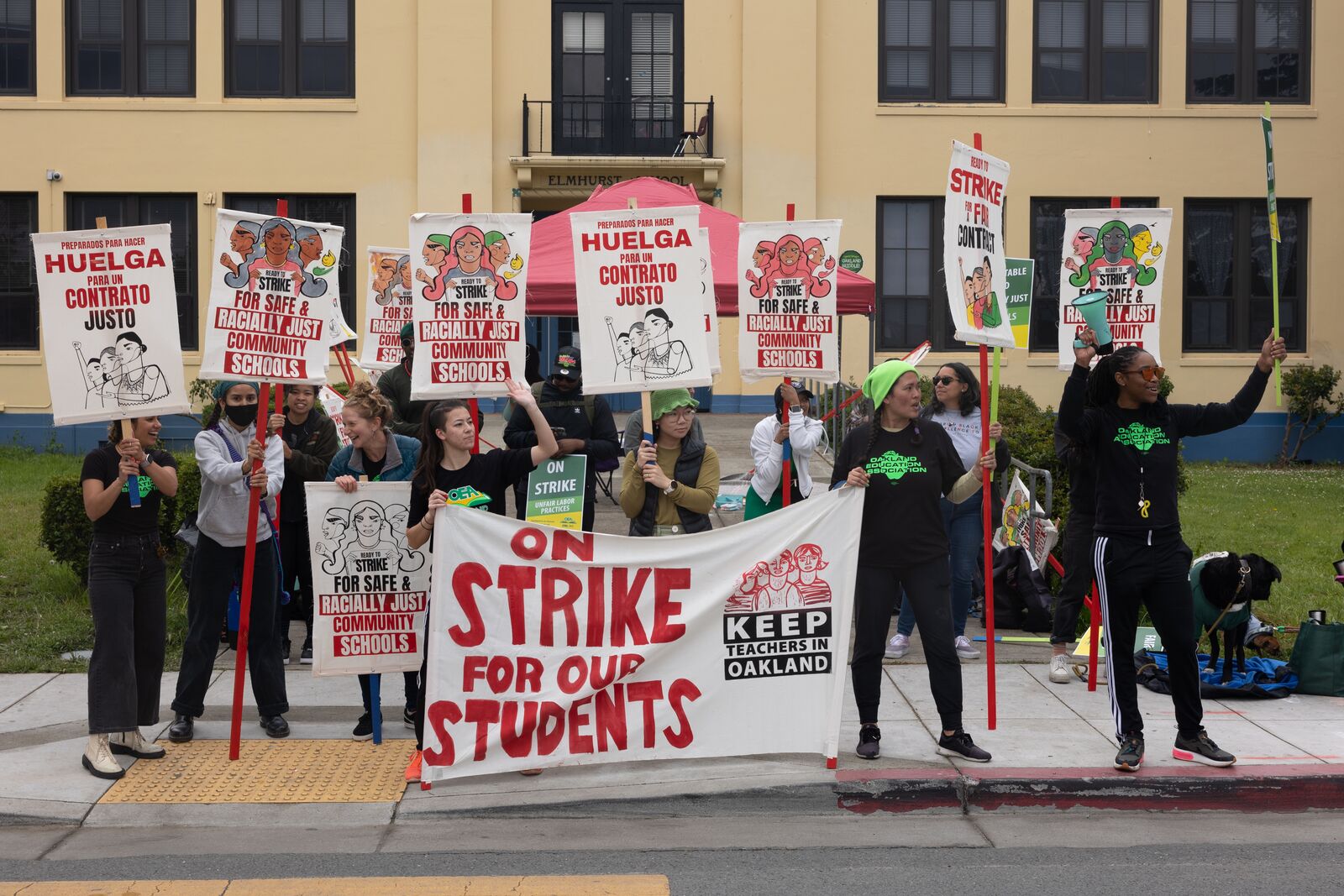Posted May 11, 2023

May 5, 2023
May 5th is the second day of the strike of Oakland teachers and those in support services, involving over three thousand members of the Oakland Education Association (an affiliate of the California Teachers Association and the National Education Association, the largest union in the US). The 111 school sites were technically open, but with no attempt at instruction for the 34,000 students; reports had only a handful of students showing up, with administrators doing some supervision.
This round of negotiations began last October, but the District team often did not show up, and/or came without any serious proposals, including on compensation. This dismissive approach toward bargaining led to numerous charges of unfair practices; the current strike is a ULP (Unfair Labor Practices) action, much like the recent strike at the University of California. It can be open-ended but not necessarily so. The District sought ‘injunctive relief’, which was rejected by PERB (Public Employee Relations Board) in less than two days.
It has been only in the week before the strike that some actual negotiations got off the ground; the District Superintendent, Kyla Johnson (sadly, a former teacher) made her first appearance last Friday.
There is no question that compensation is central to any settlement. Oakland’s salary schedule is not only far below the surrounding districts,
but ranks last of the 22 largest districts in CA (when adjusted to local cost of living). That said, after months of stonewalling and aiming to move any possibility of striking into the last month of the school year, the District came in with a possible wage proposal, if nearly all other demands were dropped. The District’s offer would increase wages from 13 to 23% based on years of service (their earlier proposal would have excluded nearly a third of the bargaining unit); it would be retroactive to November and would also include a $5000 bonus. It would move a starting salary from $52,905 to $63,604, near the Alameda County median.
The issues the District has rejected and/or provided no counter to are class size, workloads in special ed, programs for students with disabilities and facility improvements/ safe environments. There was some movement on workload for nurses and for support for electives (especially visual and performing arts), but since the strike began on Thursday (5/4) there have been no counter offers from the District. There are a range of ‘demands for the common good’, especially around establishing ‘community schools’ (with democratic control) and processes for negotiating around any further school closures. There are also proposals for unhoused students and parents, including using closed schools as shelters and for environmental justice issues. The ongoing issues on “Black Reparations’ for students in predominantly African American schools (often linked to questions of school closures) are still on the table.
There are no new negotiations scheduled, as the District plays its waiting game; the County Superintendent of Education, Alysse Castro (who has a large role in overseeing the District’s budget), and State Superintendent of Public Instruction, Tony Thurmond, have sought to ‘mediate’. Despite strong electoral backing for both, by OEA and CTA, such maneuvering can lead to pressure that the union make major compromises, as it did in the last extended teachers strike in 2019.
There have been a number of rallies in downtown Oakland and different sites; a community meeting is scheduled for Saturday. The writer has visited picket lines at one of the largest high schools (Oakland High)
and middle schools (United for Success), where there was large member participation and high spirits; there were also some students and parents picketing.
The Alameda Labor Council is calling on all member unions to support the lines and rallies.
May 10, 2023
The strike of Oakland educators continues (School Day Five)
Ninety-eight per cent of the 3400 members of the Oakland Education Association are supporting the strike, which began on May 4th. While some negotiating has occurred, there are still major obstacles to a resolution, with the District still dragging their collective feet, not only resisting putting some key counters in written form, but refusing to negotiate any “common good ” issues until a few days ago. Their bargaining team seems not to have authority to consider any issues that are not mandatory under state ed code (just compensation and immediate classroom conditions).
Even their compensation offer, which to some seemed generous, has not been resolved, largely around how they ‘collapsed’ the middle levels of the salary schedule.
There are also key questions around special education and safety. The broader common good items (what we formerly referred to as ‘class wide’ issues) must be acknowledged. Such contract questions were pioneered over a dozen years back in negotiations involving the Chicago Teachers Union, later in Minneapolis and then Los Angeles. These include issues such as shelter for homeless students (over 1500
in Oakland) in unused District facilities; and ‘reparations for black students’, which had previously been linked to school closures (and teacher & parent input in such decisions). Democratic decision-making is also tied to the over $60 million in federal dollars for multi-service ‘community schools’.
Sadly, such former activists, including school board president Mike Hutchinson, have opposed such social justice efforts, as has the largely conservative Oakland NAACP. This despite numerous studies showing how central poverty is to determining student achievement in low income areas.
The members are concerned about how any TA would affect the status of a ULP strike, but know that the members vote is the determining factor. There are rallies every day, with a major action today before the school board meeting. The State Superintendent of Public Instruction, Tony Thurmond, is still involved, but politicians must not be the final arbiters; only the members, working closely with parents and community organizations, must determine the outcome.
Bill Balderston is a retired member of and political organizer for OEA, he taught for 23 years in the Oakland schools and helped lead a month long strike in 1996.
